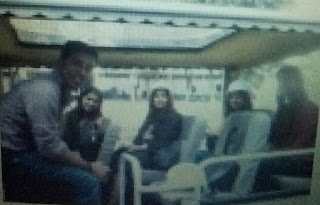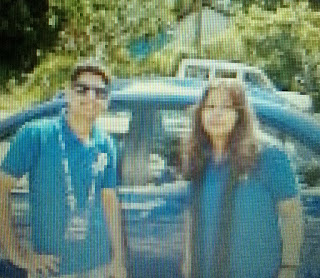The moment I hear the words “Car” “Road” “Travel” ~ my adrenaline gets pumped up high instantly. I’m a big time travel buff who literally loves to be on the road. If I had it my way, I’d be traveling 24x7. I think I was a nomadic-gypsy who lived on a caravan in my previous life. I feel I travelled all the way from the heavens onto earth, just to travel every nook and corner of this beautiful planet. And mankind has made it easier by inventing the right cars exactly at the right time. And no journey is complete without a set of good, sturdy tyres is it ~ the ones that keeps you safe on the roads and going on for hours.
The day I took my father’s car out in Bombay’s heavy traffic, ( without a proper license ) – was the day, my journey on-the-road started. Of course, later on after getting license life has been a smooth drive so far. I got to travel a lot, both in the outskirts of Bombay as well as around my enchanting hometown far up north in Assam; also multiple pan- India road trips.
The best journey I remember is my rendezvous with Nepal on road. The travel bug had bitten me, and on a whim I set forth. I was to meet up with my friend in Siliguri and take over the wheels. My friend knew the roads quite well, so I was glad I had a ready-made guide too. All I had to do was maneuver the wheels. I could barely wait for the journey to start. And we started early morning, so that we travelled as much as we could during the day and cover that much distance. There’s no visa requirement for entering Nepal ( except a certain Indian cars tax and road tax which is a nominal amount to-be paid at the border - known as 'Bhansar rate' ). Hence, without a worry about any hassles of documents, our journey began. Just to be on the safe side I carried my passport along.
The road from Siliguri to Kakarbhitta ( Nepal border ), takes around 1-2 hour, and it is one picturesque straight road. As I drove on, the mountains started looming ahead, which made the journey so exciting, the air felt crispy and smelt fresh too. With sprawling green Tea-Gardens that stretched for almost the whole length of the journey, we caught the constant whiff of the tea-plants around ( yeah, spotted some tea-pluckers too ) - such a pleasant aroma it is, you'd love to be lost in it. We saw the Darjeeling hills on our right and Nepal on left. Our direction was to be left. The borders open early at 6am and closes at 9pm ~ so we were lucky to reach much before deadline. Once reaching Kakarbhitta, we paid the tax for entire duration of our stay in Nepal and got some INR converted into Nepali Rupees. Though even INR is accepted, the value multiplies by almost double, so it’s better to get the local currency. The road tax office and foreign exchange is near the main bridge, so it was easy to find. There is a small check post just 1kms from Kakarbhitta, where we had to get a Nepali Number plate on the vehicle. It can be displayed in front of the vehicle. There are certain points where we had to pay a small tax – notably at Birtamod, which is important. So, with all these little taxes here and there, the drive went on pretty smooth.
Since the road is widely travelled by visitors from both the countries, it is a straight and well kept road. We passed by many streams that flows down from the Himalayas, main being the Mechi river ( on the border itself ), Koshi etc. These streams and tributaries flow underneath bridges, so there are countless bridges you come upon on the road. The tall trees on both sides, makes the journey even more beautiful. You feel you are driving alongside nature.
We halted some time in a town called Biratnagar about 4 hours from Kakarbhitta. And again set forth. As we drove more, the Himalayas got more and more closer to us. The road sometimes smooth, sometimes jerky, sometimes with potholes – had to be very careful while driving. But with michelin's sturdiness we were left assured. Instead of driving straight to Kathmandu, we drove ahead to a very beautiful place called Dhulikhel. It lies on the way to Nepal-China border. The view of the Himalayas is simply breathtaking from here. The green valley with traditional Nepali hutments and with the mountainous landscape behind makes a great picture. There are some great tourist resorts here to relax – just perfect after a long tiring journey on road. The road back, in such high altitude is filled with Pine trees. So, a treasure indeed for photographers! We stopped the car many times to take pictures of ourselves, in these pristine settings.
The next day we drove to Kathmandu. Kathmandu is a must visit if you are travelling in Nepal. Till not long ago, Nepal was a kingdom with kings and all, so you won’t be surprised to see the attachments to royalty here. If you want to increase your stay, you might have to pay some extra tax – and we did just that. Kathmandu has some amazing places – and many of them declared heritage sites. Bhaktapur is one of the oldest parts of Kathmandu and many things are still unchanged here ( the 15'earthquake aftermaths visible though ). The various palaces, squares & courtyards, temples and even the many idols at almost every places, had us enthralled. The areas around the Buddhist temples/monasteries ( with some world famous stupas declared heritage pilgrim sites ) that are quite a common sight, gave out some of the most overwhelming drifts of incense-fragrances which filled the whole air. We also bought some pottery and metal wares as souvenirs.
The most intriguing fragrance that stayed with us on this journey is our chance encounter with the Nardostachys Jatamansi plant ( also known as spikenard; nard, nardin & muskroot ). While we were returning, just as we were passing through a crowded local bazar area, we spotted a man standing at the edge of the narrow road with an open basket wherein was loaded with interesting looking colourful goods. He spotted our car and came after us, waving for us to stop. We discovered that he was a local Nepali. Excitedly, on dscovering that we were Indians, he asked us to buy some of his incense and oil. Not sure, we agreed reluctantly to purchase only if it was locally produced. We were afterall there to experience the local culture and produce. He took us to a garden not far from where he stood, through a small path, and we were left simply breathless with the zest of a very unique fragrance. The local explained how the plant's underground stems were crushed and distilled to manufacture a very aromatic oil ~ which is also used as perfume. ( along with other uses too )
http://upload.wikimedia.org/wikipedia/commons/thumb/a/aa/Nardostachys_grandiflora.jpg/220px-Nardostachys_grandiflora.jpg
This plant grows mainly in the Himalayan terrain, the place we covered and has small cute bell-shaped flowers. I'd love to bring this wonderful local fragrance of the Himalayas to my home again.
So loaded with lots of memories, feasting ourselves with piping hot Nepali 'momos' and 'wai wais' along with other mouth-watering local cuisines, after a couple of days stay in Nepal, also armed with loads of locally produced goodies, we headed back to India. Exit from Nepal can be from any point and not necessarily the point we started ( eg. Jogbani, Sonauli, Bahraich, Banbasa, Raxaul etc ). This drive was unquestionably the most thrilling and exciting, and remains so till this day.
 
Maybe Michelin can hold some kinda Himalayan rally too, some day, in this ethereal country and I’ll gladly take part in it too. For now, I would love to experience the Malaysian Sepang International Circuit.
¸¸.•*¨*•♫♪¸¸.•*¨*•♫♪¸¸ |





















































































No comments:
Post a Comment
This Blog Appreciates Precious Comments from all except Copycats!